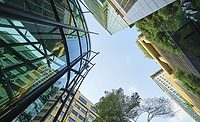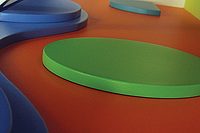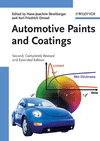Green Buildings, Sustainability, and Cities of the Future
A PCI Interview with AkzoNobel
 PCI recently asked Baron Schreuder, AkzoNobel’s new North America Powder Coatings Commercial Director, about the role coatings play in designing buildings of the future and what the coatings manufacturer is working on in the architectural space with powder coatings.
PCI recently asked Baron Schreuder, AkzoNobel’s new North America Powder Coatings Commercial Director, about the role coatings play in designing buildings of the future and what the coatings manufacturer is working on in the architectural space with powder coatings.
PCI: What role do paint and coatings play in sustainable urban design?
Schreuder: As we head deeper into the 21st century, one of the biggest challenges facing the built environment is finding effective ways to reduce its environmental footprint (buildings are responsible for close to 40% of global energy-related carbon emissions). So, whether it’s in their design, construction, or operation, the buildings we live and work in are going to have an increasingly important role to play in making our cities and communities more sustainable.
As a company that’s committed to creating more green buildings, this is a major opportunity for AkzoNobel. We supply a wide range of products and technologies that can help confront some of the challenges the built environment is trying to overcome.
In North America, powder coatings are one of our integrated solutions for the construction sector, and we have developed a range of paint and coatings qualified for green building certifications based on the World Green Building Council's focus areas of climate action, health and well-being, and circularity.
Our powder coatings enhance the lifetime of buildings. As the planet continues to warm up, it means cities located in hotter climates in particular can benefit from incorporating these smart coatings into their design. For example, we developed a low-solar-absorption powder coating that contains a reflective pigment that deflects infrared light—and the sun’s heat. It has been developed to limit the phenomenon of urban heat islands and global warming. It aims to improve people’s everyday quality of life and reduce their energy costs. Another example of our products and the role they play in urban design is a powder coating that we developed that helps re-imagine the aluminum effect in architectural designs. The range helps architects and designers imagine designs that have the look of anodized aluminum but with a minimal environmental impact. The powder coating process does not require metal to be immersed in an acid bath, avoiding the need to dispose of hazardous waste, and supporting a significantly more sustainable process.
Additionally, we have a powder coating that was used on the MGH, Harvard, and MIT Ragon Institute building that is also LEED-gold certified. These buildings are at the forefront of infectious disease research, and are an important urban nexus at the edge of Kendall Square in Cambridge, Massachusetts. We are proud that we developed this powder coating to serve the North American market, and to give aluminum surfaces the beautiful natural look and texture of stone, without any of the inconvenience or cost associated with using the actual material. With stone-effect finishes much in demand in North America, architects are constantly striving to find ways of achieving the look and quality of stone, without any of the issues related to sourcing, transporting, installing, and maintaining the real thing. Using our powder coating removes these challenges and brings a number of further benefits. For example, natural stone erodes over time; but our powder coating protects aluminum surfaces over the long term and is free from any volatile organic compounds that are harmful to the environment.
PCI: What current technology stands out the most to you, when imagining the city of the future?
Schreuder: Our powder coatings business co-developed revolutionary software by using artificial intelligence to help customers improve the application process and reduce their carbon footprint.
The industry-first technology, Flightpath Pro, optimizes equipment settings to reduce defects and overspray, and improve powder consumption—helping reduce costs, avoid rework, and save time and energy. The AI-based software has been in development for two years, and an exclusivity agreement has just been signed by both parties, who joined forces after first crossing paths during AkzoNobel’s Paint the Future start-up challenge in 2021.
This new technology enables customers to optimize equipment settings such as gun motion, and achieve more uniform, consistent coverage with fewer flaws—all thanks to AI-powered recommendations. It doesn’t require complex integration, and, as conditions change, it continually adapts its recommended parameters. We are excited for the future possibilities of AI in the paint and coatings industry, and to see how it will play a role in the cities of the future.
PCI: What kind of functionality would you hope our industry can engineer for a future city?
Schreuder: Our innovation is focused on developing technology and solutions that meet our customers' technical challenges and performance demands. It’s all about transforming spaces and environments to ensure they fit the ever-changing requirements of modern living and lifestyles.
In Europe, we have developed a consulting process and an energy and carbon footprint calculator so that customers can estimate the savings they could achieve with the company's powder coatings products. We look forward to the future and what technology will be developed in North America as we continue to transform the spaces we live and work in.
PCI: Is there any avenue in which your technology might intersect with bio-technology in an urban setting?
Schreuder: For 2024, we believe powder coatings will continue to be a growing technology. Our products protects against the negative effects of odor-causing and staining microbes, such as bacteria and mold. We also have a powder coating can be used on a variety of internal surfaces, such as window frames, ceiling tiles, metal office partitions, metal doors, and elevator doors. Along with our anti-microbial range of coatings, which is typically used on surfaces in hygiene-conscious areas.
PCI: Is there anything else you would like our readers to know about?
Schreuder: AkzoNobel offers material transparency to our customers as they compare product options, and assists customers in reducing their carbon footprint. AkzoNobel is the first global paint and coatings company to follow up on its commitment to set science-based sustainability targets by announcing carbon reduction targets for its full value chain, and gaining official validation from SBTi. An Environmental Product Declaration (EPD) is an independently verified assessment of a coatings’ environmental impact across its whole lifespan, from raw material supply through manufacturing, product use, and end of life. An EPD provides total transparency for those in the built environment, seeking sustainable powder coating solutions and partners, as well as contributes to Green Building certificate points. One of our powder coatings has been granted with an EPD not just once, but for a historic third time. Read more about AkzoNobel's involvement in sustainable solutions.
*Images courtesy of AkzoNobel.
Looking for a reprint of this article?
From high-res PDFs to custom plaques, order your copy today!








